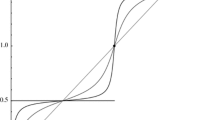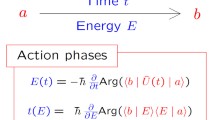Summary
The significance of the energy-momentum conservation laws, as consequences of the general invariance principles, is much enhanced if the momentum, and hence the energy, can be coupled, still by means of the invariance principles, to some directly observable quantity. If the positions of particles can be measured in the quantum-mechanical sense, and if the corresponding operator satisfies the obvious invariance requirements, the velocity can also be ascertained and its relation to the momentum four-vector can easily be derived from the displacement invariances. Serious doubts have been cast, however, on the measurability of the position. Hence, a more primitive method of measuring the velocity, by means of « traps » is described; it is essentially the experimental method. The connection between momentum and velocity is then derived, for the velocity measured in this way, from the displacement invariance principle.
Riassunto
Si aumenta molto il significato delle leggi di conservazione dell’energia-impulso, come conseguenza dei principi di invarianza generale, se l’impulso, e quindi l’energia, può essere accoppiato, ancora per mezzo dei principi di invarianza, a qualche quantità direttamente osservabile. Se le posizioni delle particelle possono essere misurate, nel senso della meccanica quantistica, e se l’operatore corrispondente soddisfa ad ovvi requisiti d’invarianza, anche la velocità può essere accertata e la sua relazione con il quadrivettore dell’impulso può essere facilmente ottenuta dalle invarianze di spostamento. Sono sorti, comunque, seri dubbi sulla misurabilità della posizione. Quindi si descrive un metodo più primitivo di misurazione della velocità per mezzo dei « trappole »; è essenzialmente il metodo sperimentale. Si ottiene quindi, dal principio d’invarianza dello spostamento, la connessione fra l’impulso e la velocità, quando la velocità è misurata in questo modo.
Реэюме
Значимость эаконов сохранения знергии-импульса, как следствий обших принципов инвариантности, еше более усиливается, если импульс и, следовательно, знергия могут быть свяэаны с помошью принципов инвариантности с некоторыми непосредственно иэмеряемыми велчинами. Если положения частиц могут быть иэмерены в квантовомеханичес ком смысле и если соответствуюший оператор удовлетворяет очевидным требованиям инвариантности, то скорость также может быть определена, и свяэь скорости с четырех-вектором импульса может быть легко получена иэ инвариантности относительно смешений. Однако, наиболее серьеэные сомнеия выэывает воэможность иэмерения положения. Позтому описывается более примитивный метод иэмерения скорости с помошью « ловущек »; который представляет основной метод зкспериментального иэмерения. Затем выводится свяэь между импульсом и скоростью для скорости, иэмеренной укаэанным обраэом, испольэуя принцип инвариантности смешения.
Similar content being viewed by others
References
See, for instance,a)E. Wigner:Gruppentheorie und ihre Anwendung auf die Quantenmechanik der Atomspektren (Braunschweig, 1931); or
(1)b) a somewhat extended English translation byJ. J. Griffin (New York, N. Y., 1959); or
(1)c)M. Hamermesh:Group Theory and its Application to Physical Problems (Reading, Mass., 1962).
A determination of some of the properties of the stationary states (Chap. 19 of ref. (1b)) falls into this category. So does the solution of problems such as the probability of a certain component of the angular momentum if the component in another direction is given.
The connection between invariance and conservation laws in classical mechanics was first noticed byJ. R. Schütz. SeeNachr. Akad. Wiss. Göttingen Math. Phys. Kl., (1897), p. 110. For the early recognition of this connection see alsoG. Hamel:Zeits. Math. Phys.,50, 1 (1904). The later, more explicit and sophisticated articles ofF. Engel (Nachr. Akad. Wiss. Göttingen Math. Phys. Kl., (1916), p. 270) and ofE. Noether (Nachr. Akad. Wiss. Göttingen Math. Phys. Kl., (1918), p. 235) are more often quoted. For the history of the subject, seeP. Havas’ article (Acta Phys. Austriaca,38, 145 (1973)) andF. Klein’s bookVorlesungen über die Entwicklung der Mathematik im 19 Jahrhundert (Berlin, 1927) quoted therein.
For some applications of the reflection symmetries, see for instance Chap. 18 and 26 of ref. (1b). Inaccuracies of these symmetries were suggested toT. D. Lee andC. N. Yang by some puzzling phenomena in particle physics and first proved byWu, Ambler, Hoppes andHudson. See the Nobel lectures ofC. N. Yang and ofT. D. Lee, reprinted inScience,127, 565, 569 (1958). Another departure from a reflection symmetry was proved byJ. H. Christenson, J. W. Cronin, V. L. Fitch andR. Turlay. SeePhys. Rev.,140, B 74 (1965) and many later publications based thereon.
The most elegant and convincing evidence for this was presented byG. C. Hegerfeldt:Phys. Rev. D,10, 3320 (1974). An indication in this direction is contained already inW. Pauli’s articleDie allgemeinen Prinzipien der Quantenmechanik inGeiger-Scheel Handbuch der Physik, Vol.24 (Berlin, 1933), p. 91.
Cf.E. Wigner:Ann. of Math.,40, 149 (1939);V. Bargmann andE. P. Wigner:Proc. Nat. Acad. Sci.,34, 211 (1948). We use the results and the notations of these articles.
SeeF. E. Goldrich andE. P. Wigner: chapter inMagic Without Magic, edited byJ. Klauder (San Francisco, Cal., 1972), p. 147. Actually the trap will not act instantaneously; its operation will require some time. However, this does not alter our argument except thata)t must denote the center of the time interval of the operation of the trap andb) the duration of the operation of the trap must be very short as compared with the timet elapsed before the trap is operated.
P. Ehrenfest:Zeits. Phys.,45, 455 (1927). Actually, Ehrenfest’s work goes further: it also gives the time derivative of the momenta in the presence of a potential,i.e. the second time derivative of the position. In our case of an isolated system this derivative naturally vanishes—|ψ(p)|2 is not changed whenψ(p) is multiplied by exp [−ip t t].
Author information
Authors and Affiliations
Rights and permissions
About this article
Cite this article
Ahmad, S.M.W., Wigner, E.P. Invariant theoretic derivation of the connection between momentum and velocity. Nuov Cim A 28, 1–11 (1975). https://doi.org/10.1007/BF02730391
Received:
Published:
Issue Date:
DOI: https://doi.org/10.1007/BF02730391




